
The Mauser C96 is a semi-automatic pistol that was originally produced by German arms manufacturer Mauser from 1896 to 1937. Unlicensed copies of the gun were also manufactured in Spain and China in the first half of the 20th century.

A semi-automatic pistol is a handgun that automatically ejects and loads cartridges in its chamber after every shot fired. Only one round of ammunition is fired each time the trigger is pulled, as the pistol's fire control group disconnects the trigger mechanism from the firing pin/striker until the trigger has been released and reset.

The .380 ACP, is a rimless, straight-walled pistol cartridge developed by firearms designer John Moses Browning. The cartridge headspaces on the mouth of the case. It was introduced in 1908 by Colt, for use in its new Colt Model 1908 pocket hammerless semi-automatic, and has been a popular self-defense cartridge ever since, seeing wide use in numerous handguns. Other names for .380 ACP include .380 Auto, 9×17mm, 9mm Browning, 9mm Corto, 9mm Kurz, 9mm Short, and 9mm Browning Court. It should not be confused with .38 ACP. The .380 ACP does not strictly conform to cartridge naming conventions, named after the diameter of the bullet, as the actual bullet diameter of the .380 ACP is .355 inches.

The Beretta Model 1934 is an Italian compact, semi-automatic pistol which was issued as the service pistol of the Royal Italian Army beginning in 1934. As the standard sidearm of the Italian army it was issued to officers, NCOs and machine gun crews. It is chambered for the 9mm Corto, more commonly known as the .380 ACP.
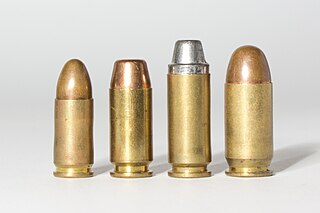
The 9×19mm Parabellum is a rimless, centerfire, tapered firearms cartridge.
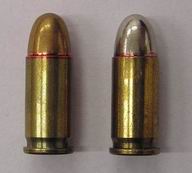
.32 ACP is a centerfire pistol cartridge. It is a semi-rimmed, straight-walled cartridge developed by firearms designer John Browning, initially for use in the FN M1900 semi-automatic pistol. It was introduced in 1899 by Fabrique Nationale, and is also known as the 7.65 mm Browning Short.

The Walther PP series pistols are blowback-operated semi-automatic pistols, developed by the German arms manufacturer Carl Walther GmbH Sportwaffen.

The 9×23mm Largo centerfire pistol cartridge was developed in 1901 for the Bergmann Mars pistol.

In American English, a pocket pistol is any small, pocket-sized semi-automatic pistol, and is suitable for concealed carry in a pocket or a similar small space.

Star Bonifacio Echeverria, S.A. was a manufacturer of small arms in the Basque region of Spain from about 1905 until 1997.
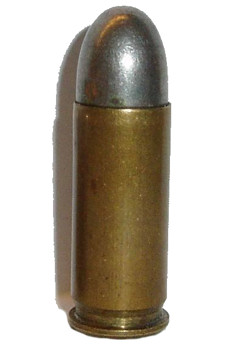
The .38 ACP, also known as the .38 Auto, .38 Automatic, or 9x23mmSR, is a semi-rimmed pistol cartridge that was introduced at the turn of the 20th century for the John Browning-designed Colt M1900. It was first used in Colt's Model 1897 prototype, which he did not produce. The metric designation for the round is 9×23mm SR (semi-rimmed), which is not to be confused with other 9×23mm cartridges.

The FN Model 1903, or Browning No.2 is a semi-automatic pistol designed by John Browning and manufactured by Belgian arms manufacturer Fabrique Nationale (FN). It was introduced in 1903 and fired the 9×20mmSR Browning Long cartridge. It should not be confused with the US-made Colt Model 1903 Pocket Hammerless, nor with the Colt Model 1903 Pocket Hammer. The FN Model 1903 is based on the same mechanical design as the Colt Model 1903 Pocket Hammerless, which Browning sold to both companies, but enlarged to handle the more powerful 9mm Browning Long cartridge. The M1903's reliability, accuracy, light weight, and quick reloading made it a popular service pistol for many police forces and militaries. The pistol was initially introduced by FN as the Browning Modèle de Guerre or Browning Grand Modèle.

A handgun is a firearm designed to be usable with only one hand. It is distinguished from a long gun which needs to be held by both hands and braced against the shoulder. Handguns have shorter effective ranges compared to long guns, and are much harder to shoot accurately. While most early handguns are single-shot pistols, the two most common types of handguns used in modern times are revolvers and semi-automatic pistols, although other handguns such as derringers and machine pistols also see infrequent usage.
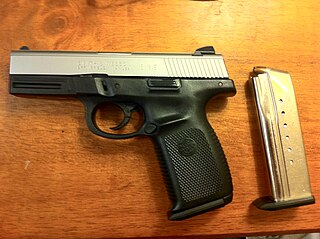
The Smith & Wesson SW series, most commonly referred to as the Smith & Wesson Sigma, was Smith & Wesson's first venture into using synthetic materials in pistol construction, with high-strength polymer material for the frame.

The Campo-Giro was a semi-automatic pistol, chambered for the 9mm Largo cartridge, which saw service in the Spanish military. It is named for its designer, Colonel Don Venancio López de Ceballos y Aguirre, Count of Campo-Giro.

Astra Unceta y Cía was a Spanish weapons manufacturer founded on July 17, 1908, under the name Esperanza y Unceta by Juan Esperanza and Pedro Unceta. Initially based in Eibar, the centre of the Basque arms industry, the company moved in 1913 to Guernica.
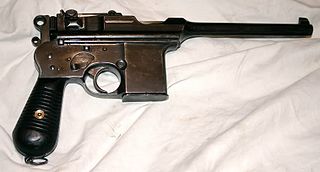
The Astra Model 900 is one of many Spanish copies of the German Mauser C96 semi-automatic pistol. It shares the same caliber, magazine capacity, and holster type and is generally very similar to the German handgun.
Llama Firearms, officially known as Llama-Gabilondo y Cia SA, was a Spanish arms company founded in 1904 under the name Gabilondo and Urresti. Its headquarters were in Eibar in the Basque Country, Spain, but they also had workshops during different times in Elgoibar and Vitoria. The company manufactured moderate-priced revolvers and self-chambering pistols in a wide variety of models. These were popular mainly in the European and Latin American export market, as well as domestically in Spain.

The 7.65×21mm Parabellum is a pistol cartridge that was introduced in 1898 by German arms manufacturer Deutsche Waffen- und Munitionsfabriken (DWM) for their new Pistol Parabellum. The primary developers of the pistol cartridge were firearms designers Georg Luger and Hugo Borchardt, who developed the round from the earlier 7.65×25mm Borchardt while working at DWM.



















